High-performing affiliates are worth their weight in gold – they’ll help grow your brand and bring you a constant stream of traffic and sales. And you only pay them in commission.
From a brand’s perspective, it’s a pretty sweet deal 🤝
There’s just one problem: like a pair of skinny jeans in a Zoomer’s closet, quality affiliates are hard to find.
Hard, but not impossible. Get it right by leveraging one (or several) of these tried-and-trusted tactics for finding affiliates…
1. Partner with loyal customers as affiliates
Loyal customers are the beating heart of any ecommerce brand, generating 44% of revenue and 46% of orders – despite making up just 21% of the customer base 🤯
Not only are they likely to buy from you again: they’re also happy to send new customers your way. Indeed, SAS Emarsys research shows that 47% of loyal consumers recommend their favorite brands to friends and family.
This word-of-mouth marketing – also known as customer advocacy – is fabulous for brands since it comes from people who already:
- Love your product
- Understand its benefits
- And have stories that resonate with other potential customers
Many loyal consumers are willing to promote your brand for free… so just imagine how many more referrals they’d bring in if you paid them!
The best part? Asking satisfied customers to join your affiliate program increases their loyalty to your brand because they feel heard and valued by getting a cut each time they recommend you to their peers.
But how do you find faithful customers you can invite to become affiliate partners?
Check social media for brand mentions
Some of your loyal customers might share about your brand on social channels. For example, Palesa – a happy customer of Pastry Skincare – shared how helpful she finds the company’s products in a Tweet with over 4,000 likes.
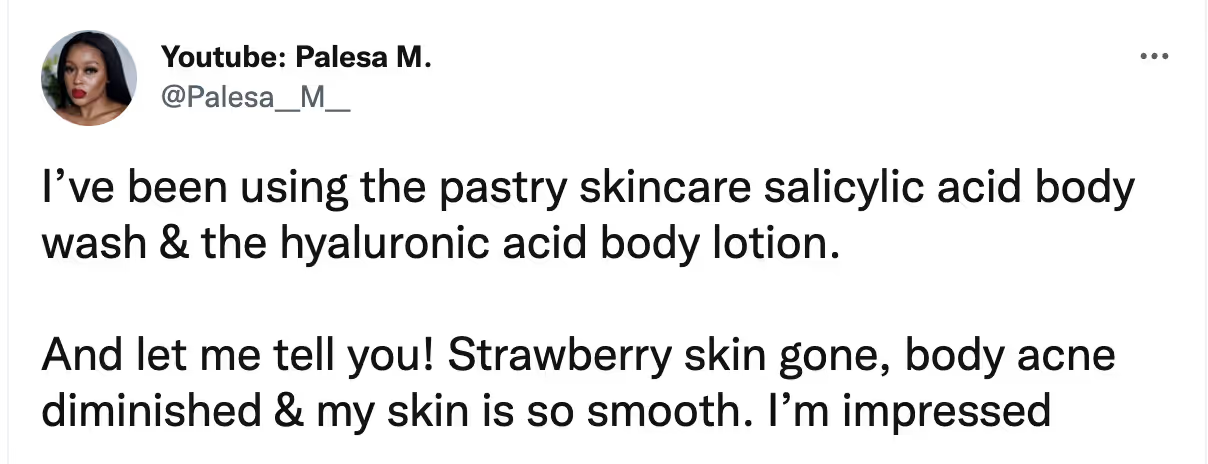
A great way to capitalize on positive reviews like this is to graduate the reviewer from a happy customer to an affiliate by giving them a unique UTM link or discount code.
You never know which of your customers are influencers who can help you tap into a sizable audience.
🤓Pro tip: Not everyone who mentions you on social will tag your brand (case in point: Palesa didn’t tag Pastry Skincare in the above example). So get into the habit of searching social platforms for your brand name, or save time with a social listening tool. For best results, use Event Mode in Modash’s influencer tracking tool, which automatically tracks and stores influencer content – even when they forget to mention you, tag you, or use your campaign hashtags.
Promote your affiliate program in marketing emails and on social
Instead of going out and searching for loyal customers, another way to find them is by calling them to you!
Invite customers to join your affiliate program by sharing signup instructions on your order confirmation emails and social media handles. Point interested customers to a landing page that has all the essentials about your affiliate program, like:
- Your commission rate
- Additional perks, e.g., store discounts, free products, and performance-related bonuses
- How to apply
Sephora gets it right with the landing page for its Beauty Affiliate Program:
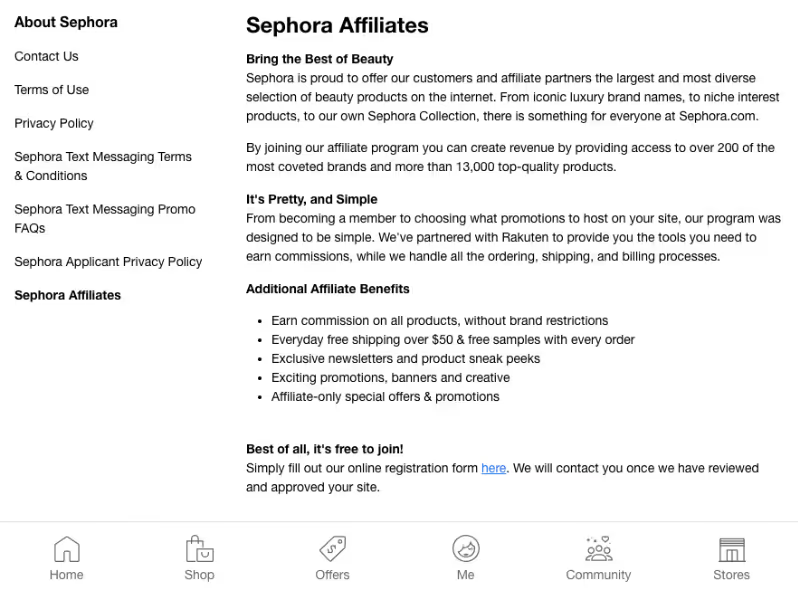
This approach attracts those who are genuinely interested in supporting your brand.
However, you run the risk of signing up too many affiliates, which can waste your time and weaken your brand – so put in place a foolproof vetting process to avoid crowding your affiliate campaigns with irrelevant, underperforming, and/or low-quality affiliates.
Proactively reach out to happy customers
Another way to find your most loyal customers is to check your order history for people who repeatedly buy from you, then reach out to them directly about joining your affiliate program.
It’s best if those high-spending customers also happen to have a few thousand social media followers to their name plus an audience that aligns with your ICP – all of which you can check on Modash’s influencer analytics platform by simply searching for their handle:
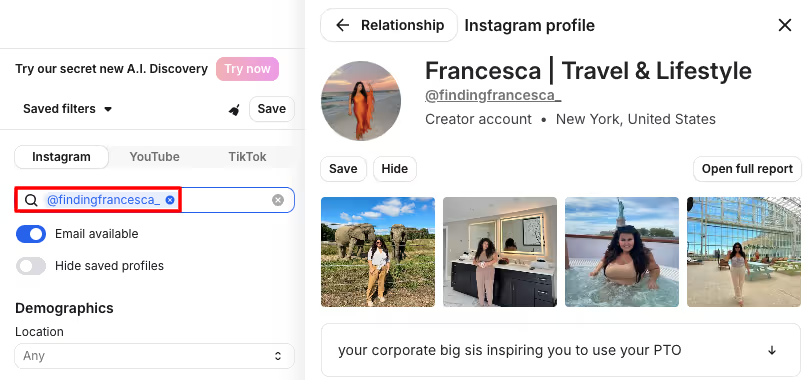
Of course, this method is more labor-intensive than some affiliate recruitment strategies, so don’t waste too much time reaching out to every customer who places a repeat order – just the ones with the highest lifetime value.
And in general, if you sell low-margin and/or low-ticket products, this approach might not make sense for your brand at all.
Let’s move on to finding affiliates outside of your loyal customer pool…
2. Seek out niche content creators and websites
Even if your product category is super obscure, chances are there are hundreds of niche content creators – bloggers, YouTubers, newsletter writers, and more – posting about it day in, day out. These creators have a ready-made audience who love hearing from them and who rely on their product recommendations.
In addition to niche creators, there are entire websites dedicated to niche topics with a built-in customer base for your brand.
By recruiting these creators and websites as affiliates, you not only get on the radar of potential new customers, but you also borrow the trust they’ve built among their followers.
How do you find these niche content creators and websites? Try these three methods…
Search for niche websites on Google
Search [your niche] review sites to find a list of review websites that might be able to list your product.
As an example, I searched for skincare review sites, and Try and Review came up:
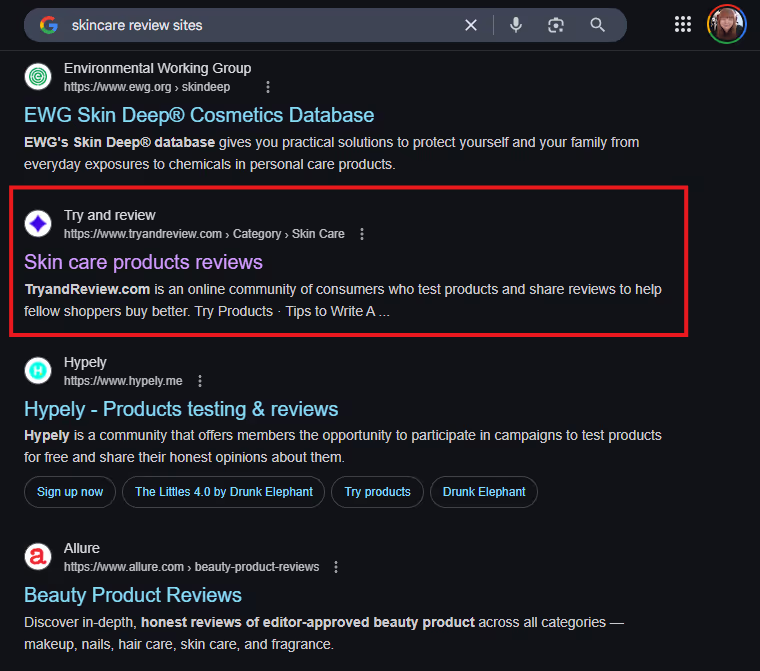
In Try and Review’s footer section, they promote their ambassador program:
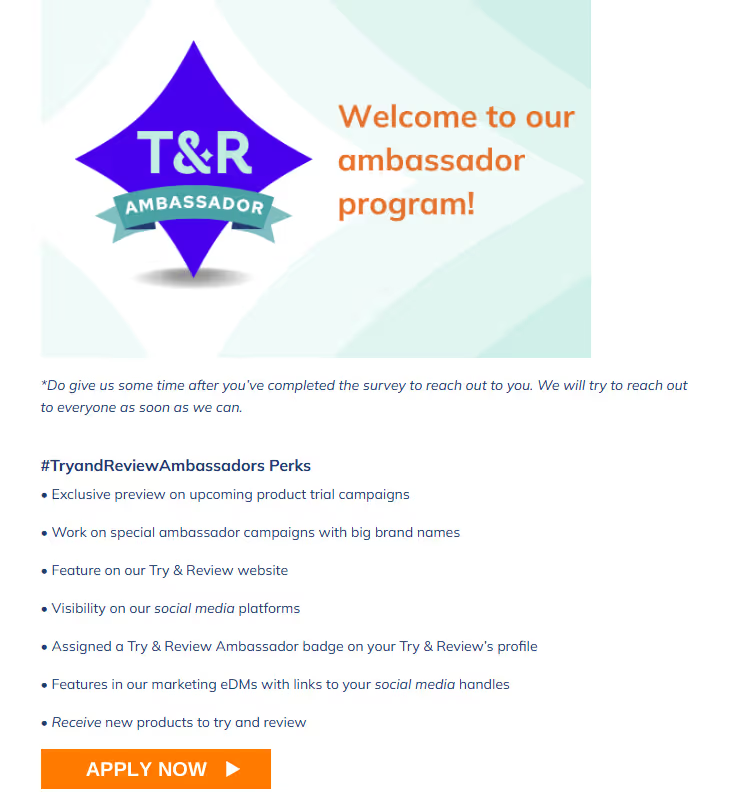
They also offer a product listing service – they’ll send out your product to their members, who will review it on their site.
When you perform your own Google search, you’ll find similar affiliate sites for your niche. Narrow down or widen your search to find hundreds of potential affiliates who can discuss your products on their website.
For example, if you specifically sell skincare products to reduce acne, just Google best products for acne. The search results will show you all the websites that regularly publish content on acne products. Maybe those sites would agree to feature your product – in return for a cut of any sales they generate, of course.
Browse social media for niche creators
Social media is teeming with niche content creators. They might not all be full-time influencers, but they’ve built a (small) following of people interested in the topics they cover.
These creators are already sharing content about products like yours. Chances are, with a little incentive – like a per-sale commission – they’d be happy to post about yours as well.
The quickest and easiest way to find niche creators is to use an influencer discovery tool like Modash.
🤓Pro tip: Once you find a creator you like, find more using Modash’s influencer lookalike tool, which identifies similar accounts based on audience or content theme.
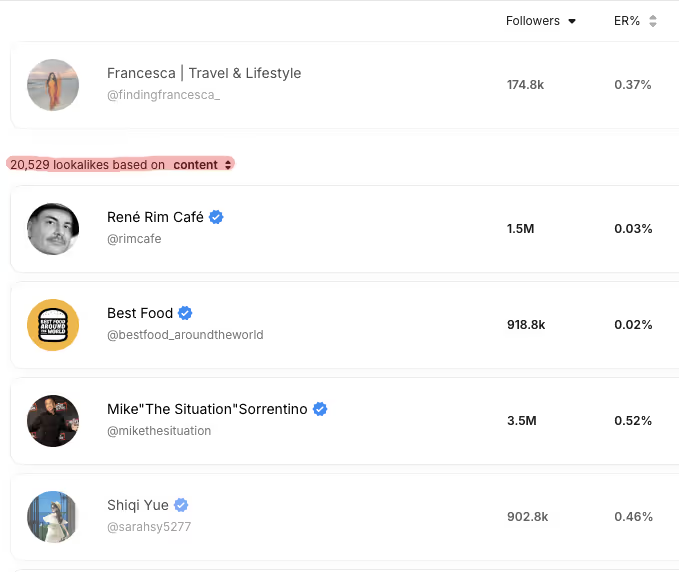
If you don’t have an influencer discovery & lookalike tool yet, you can manually search for niche creators on social channels using product-centric hashtags like #acnetreatment:

Just know that it can be time-consuming to vet every creator you find. If you’re serious about running a profitable affiliate program, you should be spending as little time as possible on manual searching and vetting.
There’s a third way to seek out niche affiliates…
Ask your customers
Your existing customers found you somehow.
They might have clicked through from an ad or a Google search results page, or stumbled across your organic posts on social media. Or maybe they discovered you through an online community.
For instance, a forum like Skin Care Talk is likely full of people looking for skincare product recommendations:
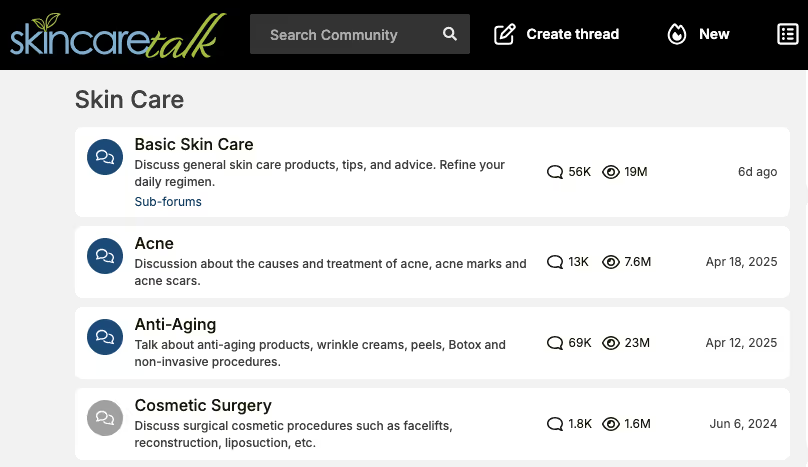
If you work for a skincare brand, maybe the good folks at Skin Care Talk (or their forum members) would be happy to earn a little passive income by steering customers toward your products?
To track down opportunities like this, simply ask customers how they found you. If multiple customers mention a specific blogger, social media creator, or community, then reach out to that person or website about becoming an affiliate.
🤓Pro tip: Some niche content creators might not have heard of your product or brand. If you can afford to, send them a free product, no strings attached. If they genuinely like your product, they’ll likely post about you for free or reach out with potential collaboration ideas.
Once you’ve exhausted your loyal customer base and hunted down niche creators and websites, you can then turn to established influencers on social media.
3. Recruit social media influencers as affiliates
While not all influencers are willing to collaborate on an affiliate-only basis, some – especially smaller accounts – will be happy with performance-based pay, especially if they already love your brand and product.
Again, the most reliable and efficient way to find relevant accounts is by using an influencer discovery tool like Modash.
In short: Modash lists every social media profile with at least 1K followers on Instagram, TikTok, and YouTube. You can search based on your chosen criteria, access their email addresses, check audience demographics, and more.
It’s painless, quick, and scalable.

Still on the fence about getting yourself an influencer discovery tool? Okay, here’s the (slightly) longer version of my soapbox:
Fact is, it’s painfully time-consuming to…
- Google affiliates
- Vet every single one with a fine-toothed comb
- Manually check their performance
You don’t need that kind of headache when running a business. By contrast, when you use Modash, you can do all of the above in under 5 clicks.
Modash has powerful filters to help you find exactly the affiliates you’re looking for in no time. Follower range, fake followers, engagement, growth rate – you name it, Modash has it.
For audience filters, we even provide percentage granularity. Only want to recruit affiliates with 50%+ female followers? Easy – just hit that percentage filter:

Modash also gives you the inside scoop on an influencer’s performance data without forcing you to reach out and ask them for screenshots. Our influencer analytics data details everything from an influencer’s most popular posts to their follower growth and the number of likes they’ve generated in the last six months.
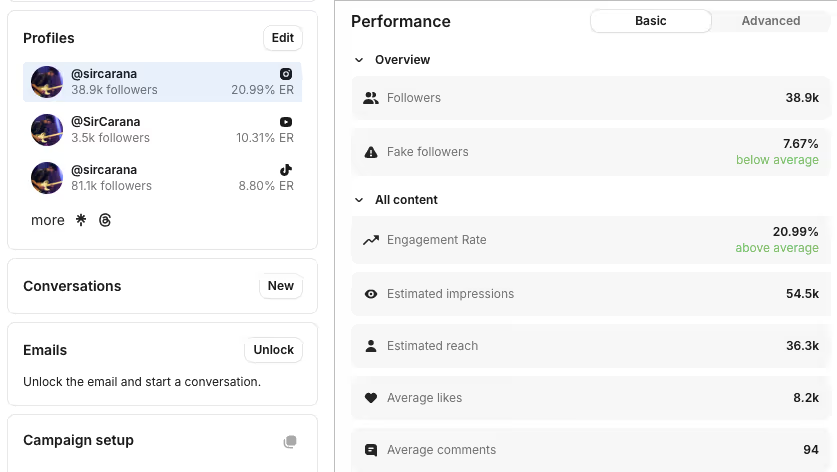
Here’s how to use Modash to find and partner with your next affiliate:
👉Step 1: Head to Discover and choose your channel
Modash features every public profile on Instagram, YouTube, and TikTok with 1,000+ followers. So the first step is to select the channel you’re targeting with your affiliate marketing efforts.

👉Step 2: Use filters to find your ideal affiliates
There are plenty of influencers and audience filters on Modash – narrow down your search using follower range, niche, location, growth rate, and more.
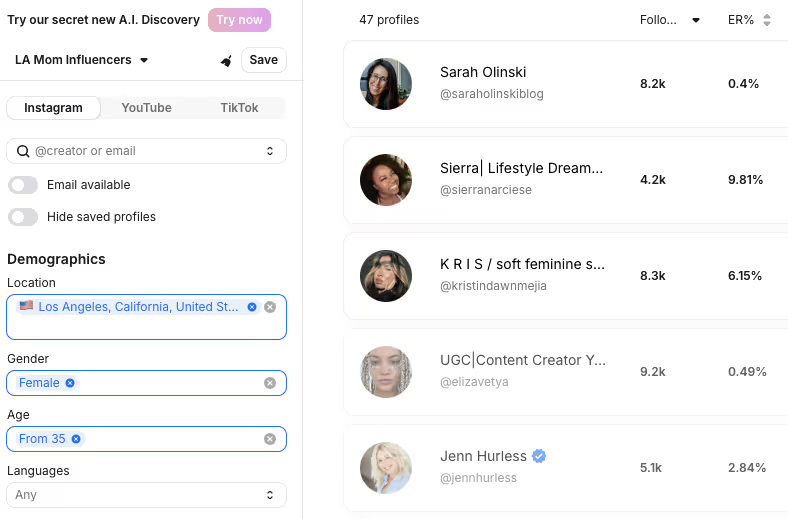
🤓Pro tip: Start with just one or two filters, then trim down the results with additional filters as necessary. This will ensure you don’t miss the perfect affiliate partner by getting too specific in your initial search.
👉Step 3: Take a deeper look at potential affiliates
Modash provides a full-scale profile summary for each affiliate – recent likes, popular posts, follower growth, brand affinity, and more. You can also see if they overlap with your audience’s demographics and interests through follower data.
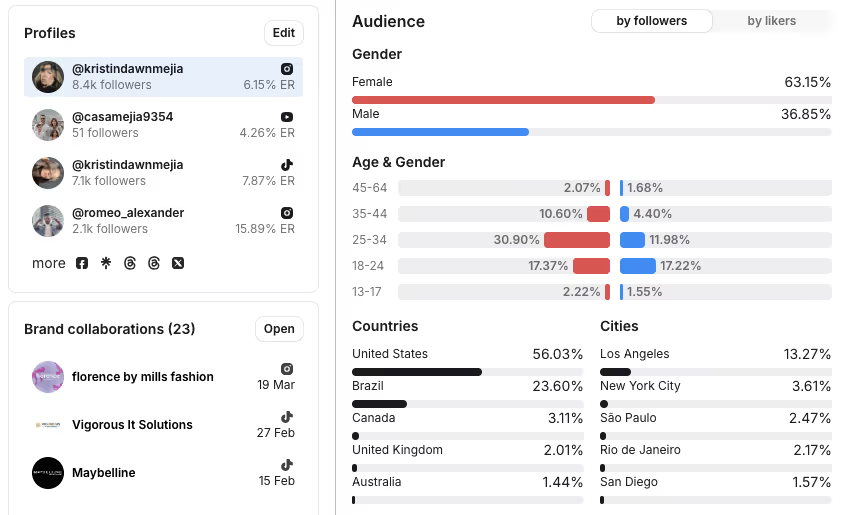
You’ll save countless hours by only getting in touch with those who seem like a strong fit for your brand and audience according to Modash’s data.
🤓Pro tip: For advice on contacting potential influencer partners, check out our in-depth guide on how to do influencer outreach.
Beyond social media influencers, who else has built-in credibility and is ideally positioned to promote your brand? Enter KOLs…
4. Collaborate with industry experts
Trust is a key factor in buying. Research from Adobe shows that:
- 67% of consumers buy more from brands they trust
- 70% will stop buying from a brand if their trust is broken
So it’s in your best interest to build deeper, more trusting relationships with your audience. This process can take years – but you can potentially speed it up by collaborating with respected experts in your niche. Otherwise known as key opinion leaders (KOL), these experts are strongly trusted, and their opinions can have a major impact on consumers’ purchase decisions.
KOLs come in all shapes and sizes – they can be bloggers or influencers, or an employee at a well-known company in your field.
These people make ideal affiliates, lending you credibility and boosting your sales. Here’s how to find them:
- Ask customers: Send a survey to ask customers who they turn to for product recommendations in your niche. Their answers might point to a key opinion leader in your space.
- Participate in industry events: Who are the expert speakers at your industry events? Consumers trust them, so seek out these speakers during the event to pave the way for a long-term partnership.
- Subscribe to industry-specific communities and newsletters: There are communities and newsletters for everything. Hunt on Google for these audiences in your niche, and you’ll soon land on an influential thought leader who would make a great affiliate marketer for your brand.
Just be aware that KOLs understand their value, so don’t be shocked if they ask for an upfront fee to post about your product, rather than “just” an affiliate discount code.
So much for outbound affiliate recruitment. What about inbound?
5. Build an affiliate landing page to drive inbound recruitment
As I’ve already noted, manual recruitment isn’t an option for brands with growth in mind as it’s way too labor-intensive.
Sure, if you only want to work with a handful of Super Affiliates, manually recruiting them is fine. But top-performing affiliate programs typically have thousands of members… are you really going to vet them all yourself? 🙅♀️
I thought not, in which case, you ought to start driving inbound recruitment – put another way, make affiliates come to you.
To pull it off, you’ll need a dedicated landing page for affiliates. Promote it via social media, emails, and blog posts – and don’t forget to optimize it for keywords like [your niche] affiliate program to target creators who are actively searching for programs like yours.
Here are a few best practices for creating a stellar affiliate landing page:
Design a curiosity-driven hero section
Grab the creator’s attention as soon as they land on the page. Make your header eye-catchy and intriguing, like Seed does, and invoke curiosity that’ll make potential affiliates scroll down to learn more.
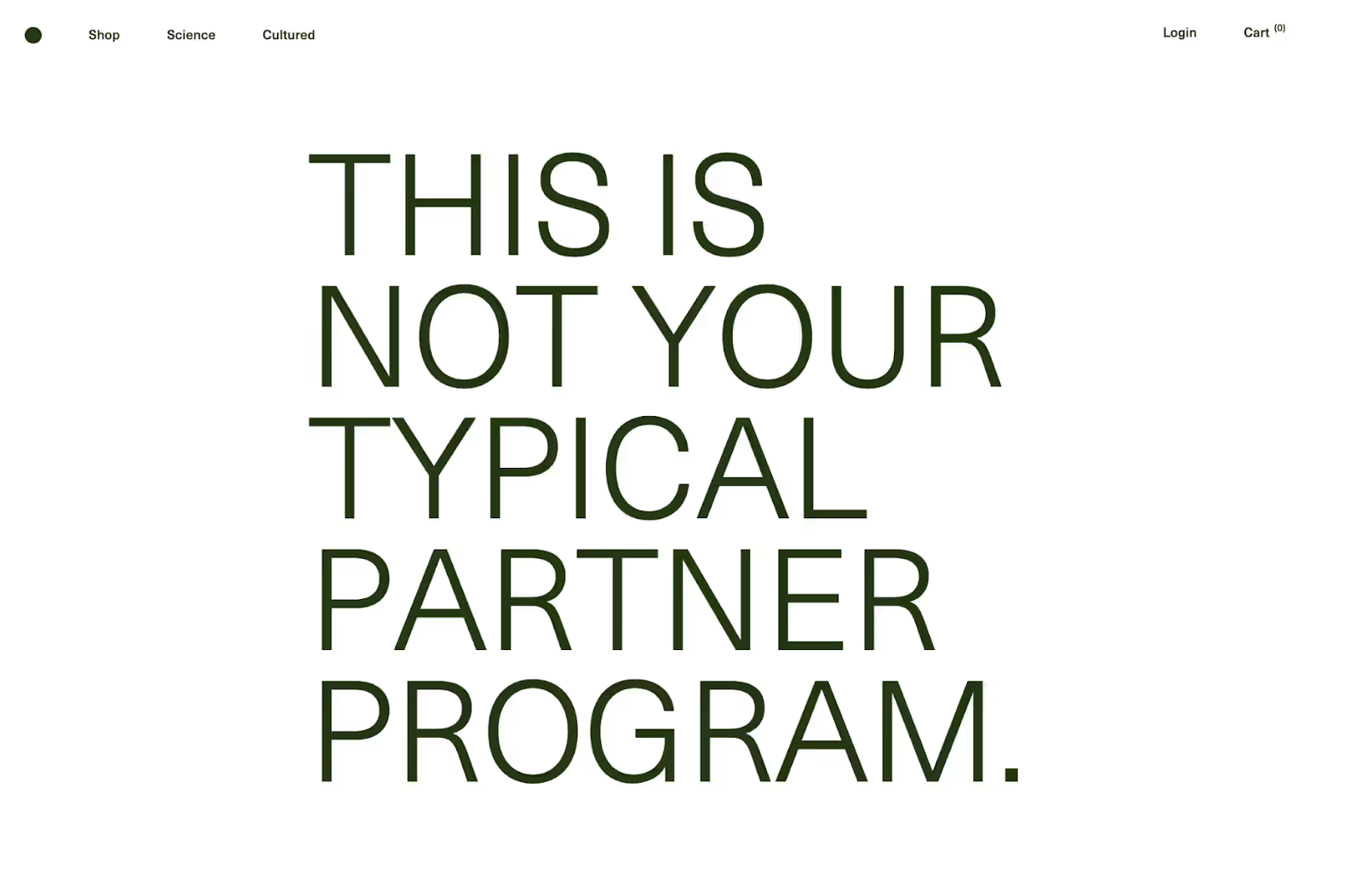
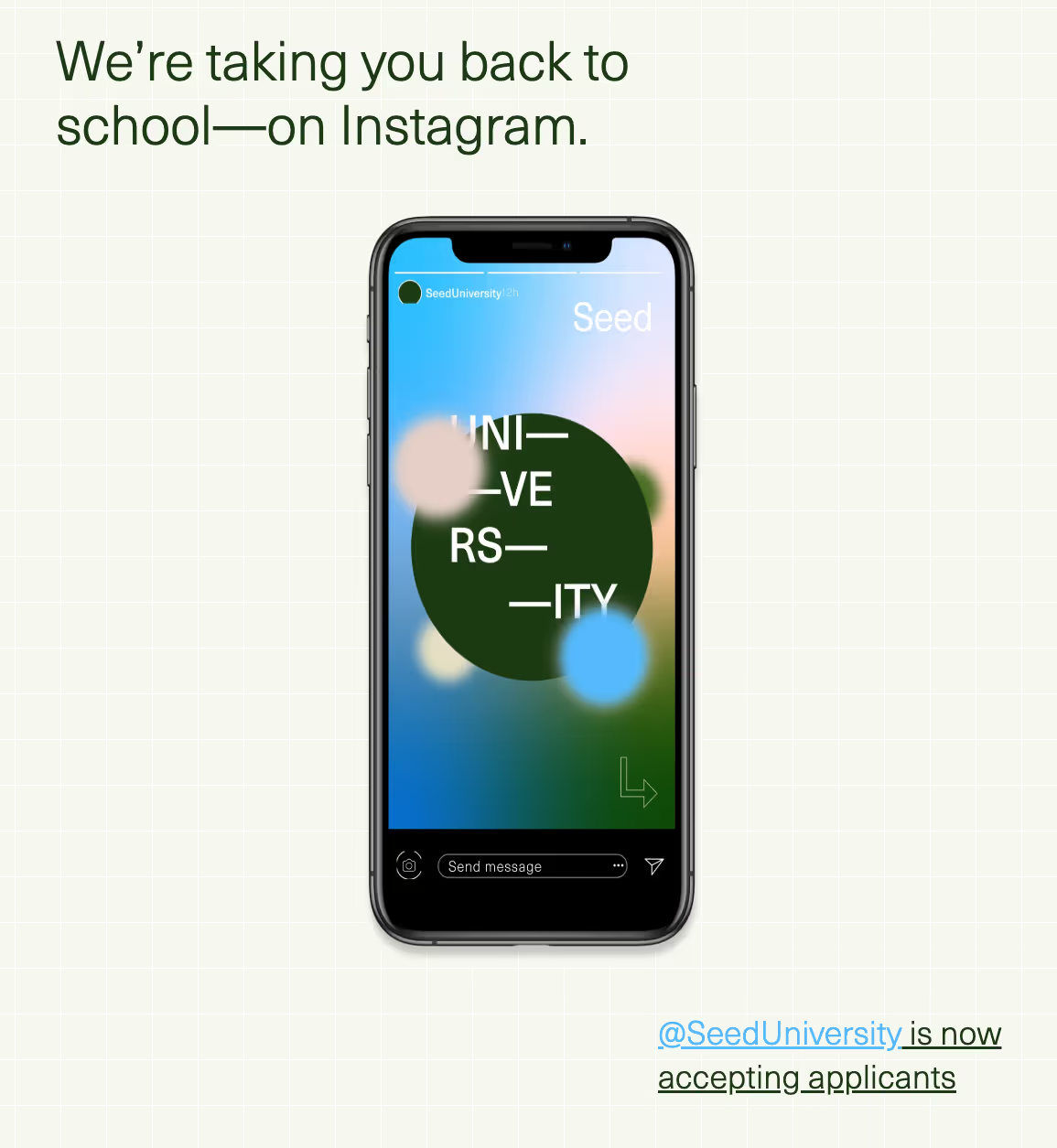
Keep the copy simple yet compelling
Get creative with your website copy to encourage visitors to become your advocates. Add some personality to your writing and speak directly to your ideal affiliates. Decathlon does this well with its purpose-driven copy:

Explain what’s in it for them
Your affiliate landing page is incomplete without answering why an affiliate should work with you. For the best affiliates, it’s not just about the money… so talk about your brand values, non-commission perks, and other key differentiators. Charlotte Tilbury gets it right here:

🤓Pro tip: Add an FAQ section to your landing page, too – that way, your team isn’t wasting time dealing with the same questions about your program over and over again.
6. Tap into affiliate networks
Rather than doing all the recruitment yourself, why not tap into a ready-made network of affiliates?
When you sign up to an affiliate network, you get instant access to thousands (or even tens of thousands) of active, vetted affiliates who can search for your offer and apply to join your program – sometimes in a single click. These networks also handle other key elements of affiliate marketing, from contracting and paying your affiliate partners to tracking the traffic they send to your site.
There are plenty of affiliate networks out there, but steer clear of the spammy ones. Higher-quality options include:

Signing up for an affiliate network is an easy way to recruit and manage affiliates, but it’s not all good news. From a brand’s perspective, there are several downsides to affiliate networks, including:
- High price: Affiliate networks aren’t cheap. You’ll likely have to pay a recurring platform fee plus a cut of any commissions you pay through the platform.
- High competition: You’re listed alongside competing brands, so you need to stand out… which could force you to pay higher commissions.
- (Potentially) less brand loyalty: Most people join affiliate networks to find a bunch of relevant programs rather than to work with one specific brand. So you might attract lots of interest – but not from affiliates who genuinely love your product.
Still, if you can afford them, affiliate networks are definitely worth considering because of their convenience.
7. Join relevant communities
Of course, joining an affiliate network isn’t the only way to quickly reach a large audience of potential affiliate partners.
High-performing affiliates wanna be everywhere online – after all, that’s where they make their money. And they’re always looking for new opportunities, from identifying new trends in their niche to finding new affiliate offers.
All of which means they’re often active members of communities on platforms like Facebook and Reddit. So if you can locate and join the right communities, you’ll get instant access to a ton of affiliates.
But what do those communities look like?
Well, there are plenty of dedicated affiliate marketing communities where you could post about your affiliate program, such as r/Affiliatemarketing:

There are also niche-specific communities – like r/SkincareAddiction – where you could sign up to build relationships with potential future affiliates.
⚠️Note: Be sure to read the rules of any online communities you join before posting about your program. For instance, r/Affiliatemarketing doesn’t allow unsolicited advertising of affiliate programs; you need to post your offer in the relevant sticky thread instead. Don’t get banned by inadvertently breaching group rules.
8. Find your competitors’ affiliates
Chances are, you’re not the only brand in your space with an affiliate program.
Rather than worrying about a little healthy competition, use it to your advantage by reaching out to your competitors’ existing affiliates and inviting them to promote your brand too (or instead 😈).
You might even give them an extra incentive to join your program, like offering a higher commission rate than your competitor pays or the chance to earn performance-based bonuses.
Modash makes this process easy by letting you search our influencer database for:
- Brand mentions
- Affiliate-friendly hashtags and phrases like #brandambassador and discount code

🤓Pro tip: When you’ve tracked down a potential partner, use our influencer lookalike tool to find similar affiliates based on their followers or the content they share. It’s a quick and easy way to turn one or two positive results into a bunch of relevant affiliates you can reach out to.
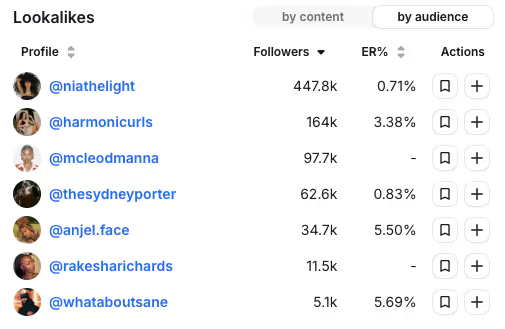
🤓Bonus pro tip: Don’t limit yourself to searching for direct competitors’ affiliates – cast the net wider by hunting for affiliates of brands in adjacent industries. For instance, a fashion brand might work with affiliates who’d love to promote skincare products.
The only thing I don’t like about targeting your competitors’ affiliates is that it looks inauthentic for some brands. If you sell low-ticket and/or fast-moving products like cosmetics, it’s probably not a problem. But if you’re a high-end brand, do you really want to work with affiliates who promoted your competitor’s product yesterday and who’ll promote yours today?
Bottom line, don’t make it seem like the affiliate partner is only posting about you to make a quick buck.
9. Hire an affiliate marketing agency
Don’t have the time or resources to run your own affiliate program? Consider outsourcing to a dedicated affiliate marketing agency.
They’re experts at running affiliate campaigns, and they’ll maintain relationships with affiliates on behalf of your brand. They even come with a built-in network you can tap into.
⚠️But remember: agencies can be expensive, so they’re not a realistic option if you have a tight budget.
It also matters what kind of affiliate agency you hire. Here are some factors you should consider before signing an agency contract:
- Case studies of past campaigns: Check out their past work to review the quality of ideas, creativity, and results they’ve produced for other clients.
- Workflows and team setup: Understand their systems for collaboration and how their team is organized to clarify any possible roadblocks. It’s important to discuss factors like a conflict of interest, communication expectations, and other such details.
- Roster of affiliates: Look through the kind of affiliates they work with to see if their talent aligns with your market and target audience.
- Program size and capacity: Ask them about the largest affiliate programs they handle – this will tell you how big a campaign you can plan with them.
One final word on this from Piia Õunpuu, who’s been there, done it, gotten the T-shirt: if you are going to go down the agency route, be sure to give your agency partner enough breathing space.
Optimize your affiliate program with Modash
Finding relevant affiliates is no guarantee of a successful affiliate program. If you’re serious about affiliate marketing, you need to monitor and track your affiliates’ content and performance.
Realistically, doing it all manually isn’t a viable solution – you need a tool like Modash.
With Modash, you can create UTM links, QR codes, and promo codes in a single platform, then track their usage across all your affiliate partners. And with our Shopify integration, you can view all your data on code redemptions, sales, and revenue on your Modash dashboard.

That way, you can easily see which campaigns and affiliates are delivering the best results 📈
And when you understand what’s working, you can do more of it.
See for yourself by signing up for your free trial of Modash – no credit card details required!








